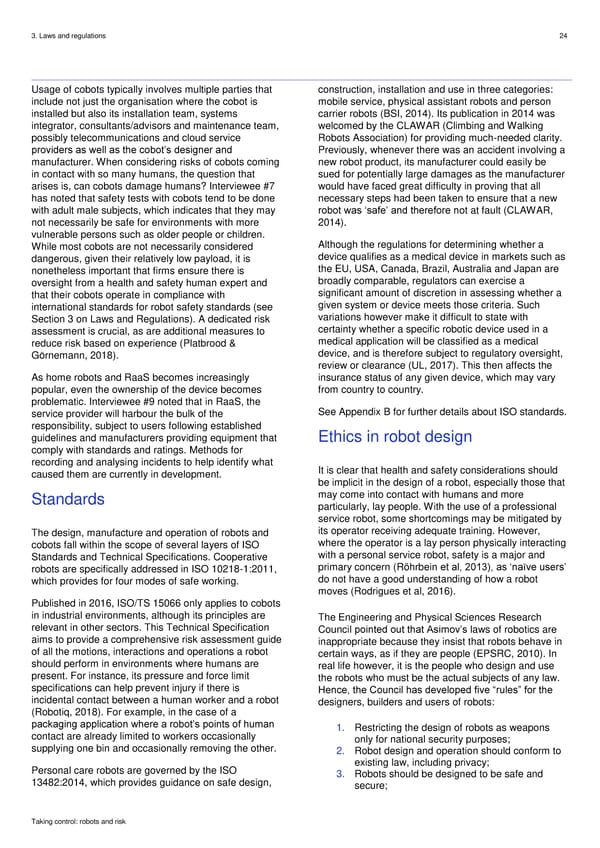3. Laws and regulations 24 Usage of cobots typically involves multiple parties that construction, installation and use in three categories: include not just the organisation where the cobot is mobile service, physical assistant robots and person installed but also its installation team, systems carrier robots (BSI, 2014). Its publication in 2014 was integrator, consultants/advisors and maintenance team, welcomed by the CLAWAR (Climbing and Walking possibly telecommunications and cloud service Robots Association) for providing much-needed clarity. providers as well as the cobot’s designer and Previously, whenever there was an accident involving a manufacturer. When considering risks of cobots coming new robot product, its manufacturer could easily be in contact with so many humans, the question that sued for potentially large damages as the manufacturer arises is, can cobots damage humans? Interviewee #7 would have faced great difficulty in proving that all has noted that safety tests with cobots tend to be done necessary steps had been taken to ensure that a new with adult male subjects, which indicates that they may robot was ‘safe’ and therefore not at fault (CLAWAR, not necessarily be safe for environments with more 2014). vulnerable persons such as older people or children. Although the regulations for determining whether a While most cobots are not necessarily considered device qualifies as a medical device in markets such as dangerous, given their relatively low payload, it is the EU, USA, Canada, Brazil, Australia and Japan are nonetheless important that firms ensure there is broadly comparable, regulators can exercise a oversight from a health and safety human expert and significant amount of discretion in assessing whether a that their cobots operate in compliance with given system or device meets those criteria. Such international standards for robot safety standards (see variations however make it difficult to state with Section 3 on Laws and Regulations). A dedicated risk certainty whether a specific robotic device used in a assessment is crucial, as are additional measures to medical application will be classified as a medical reduce risk based on experience (Platbrood & device, and is therefore subject to regulatory oversight, Görnemann, 2018). review or clearance (UL, 2017). This then affects the As home robots and RaaS becomes increasingly insurance status of any given device, which may vary popular, even the ownership of the device becomes from country to country. problematic. Interviewee #9 noted that in RaaS, the See Appendix B for further details about ISO standards. service provider will harbour the bulk of the responsibility, subject to users following established guidelines and manufacturers providing equipment that Ethics in robot design comply with standards and ratings. Methods for recording and analysing incidents to help identify what It is clear that health and safety considerations should caused them are currently in development. be implicit in the design of a robot, especially those that Standards may come into contact with humans and more particularly, lay people. With the use of a professional service robot, some shortcomings may be mitigated by The design, manufacture and operation of robots and its operator receiving adequate training. However, cobots fall within the scope of several layers of ISO where the operator is a lay person physically interacting Standards and Technical Specifications. Cooperative with a personal service robot, safety is a major and robots are specifically addressed in ISO 10218-1:2011, primary concern (Röhrbein et al, 2013), as ‘naïve users’ which provides for four modes of safe working. do not have a good understanding of how a robot moves (Rodrigues et al, 2016). Published in 2016, ISO/TS 15066 only applies to cobots in industrial environments, although its principles are The Engineering and Physical Sciences Research relevant in other sectors. This Technical Specification Council pointed out that Asimov’s laws of robotics are aims to provide a comprehensive risk assessment guide inappropriate because they insist that robots behave in of all the motions, interactions and operations a robot certain ways, as if they are people (EPSRC, 2010). In should perform in environments where humans are real life however, it is the people who design and use present. For instance, its pressure and force limit the robots who must be the actual subjects of any law. specifications can help prevent injury if there is incidental contact between a human worker and a robot Hence, the Council has developed five “rules” for the (Robotiq, 2018). For example, in the case of a designers, builders and users of robots: packaging application where a robot’s points of human 1. Restricting the design of robots as weapons contact are already limited to workers occasionally only for national security purposes; supplying one bin and occasionally removing the other. 2. Robot design and operation should conform to Personal care robots are governed by the ISO existing law, including privacy; 13482:2014, which provides guidance on safe design, 3. Robots should be designed to be safe and secure; Taking control: robots and risk
 Robots & Risk Page 23 Page 25
Robots & Risk Page 23 Page 25